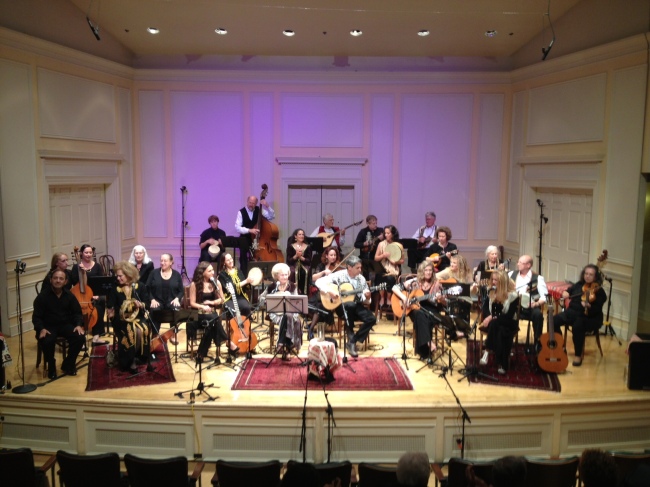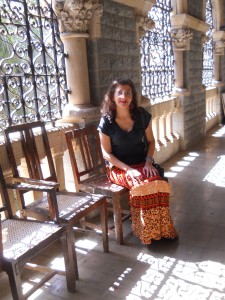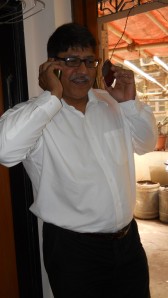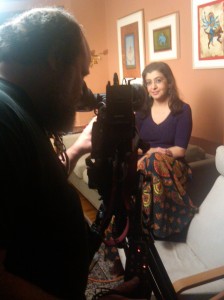We are surrounded by music in our daily lives, but seldom are we transformed by its power. The perfect combination of pitch, melody, harmony, rhythm, instrumentation, and texture – collectively infused with an all-encompassing breath of soul – is a rare occurrence. Such truly beautiful music has unrivaled power that causes the heart to soar, the mind to refresh, and the spirit to awaken in love. It is ethereal, piercing, transformative, universal. Its presence emanates like rays of sun touching our essence.
Getting swept up in one of these transcendent moments is a story worthwhile to share, and so I write today about the 90th birthday Celebration Concert of legendary musician Flory Jagoda that was held within the prestigious walls of the United States Library of Congress this past Saturday night. Long in the planning stage, the concert featured Flory and 25 others, including family members, colleagues, apprentices and students. Over decades of time, these associates have learned the songs that Flory has composed, taught and sung in her native Judeo-Spanish and Bosnian languages, all reflective of the Sephardic world of her childhood and of the generations that preceded her. A few days ago each of these very talented musicians honored their mentor by surrounding her on stage and chiming in with their voices and instruments –guitars, mandolins, violins, violas, cellos, bass, bongos, and bells –flawlessly weaving together melodies to which she gave life. The concert was presented under the auspices of the Homegrown Concert Series at the American Folklife Center of the Library of Congress.
Flory has long been known as “keeper of the flame” for preserving, perpetuating, and expanding Sephardic Jewish cultural tradition through music. She was born in Sarajevo, Bosnia in 1923, and she was raised singing melodies taught to her by her Nona (grandmother) and other family members. A recipient of the rarely bestowed National Heritage Fellowship presented by the National Endowment for the Arts, Flory has also served as a Master Artist in the Folklife Apprenticeship Program for the Virginia Foundation for the Humanities (VfH). She has performed throughout the U.S. and internationally. Her solo voice, still miraculously close to perfection even at the age of 90, opened the sold-out auditorium housing almost 500 fans. She sang the second song with her granddaughter Ariel Lowell, a 21-year old musician who inherited Flory’s complex and beautiful musical voice and is currently recording her first album. Their duet was followed by a few selections by Flory, Ariel, and three of Flory’s children – Betty Murphy, Elliot Jagoda, and Lori Lowell, Ariel’s mom. Halfway through their second song together, the side curtains of the stage opened and Flory’s colleagues, apprentices and students joined the Jagoda family’s chorus.
The songs that followed told stories that came from places and experiences that have defined Flory’s life. With a Jewish Sephardic family history that stretched back to Spain until the Inquisition at the end of the 15th century, then moved onto Turkey and spread out from there, Flory spent her early years living with her Nona, near her extended family in a small village in Bosnia called Vlasenica. She subsequently moved with her parents to Zagreb, Croatia. When World War II broke out and the Jews were forced to wear armbands with yellow stars, her parents sought refuge. They sent her ahead by herself to Split, Croatia, overcoming her 14-year old fears en route by playing her accordion in the train, which attracted the happy attention of other passengers and even ticket collectors. From Split the family escaped to the island of Korcula before ultimately arriving at a refugee camp in Bari, Italy, where she met the man who would become her husband – American soldier Harry Jagoda. After the war Flory learned that her entire extended family in Vlasenica, including her beloved Nona, had been murdered by the Ustase – the Croatian fascists who collaborated with the Nazis — and buried in a mass grave on the family property. Devastated, Flory knew that only she remained to continue the centuries-old family traditions expressed through their music.
That cultural legacy is what the concert at the Library of Congress celebrated. Flory has succeeded in creating a litany of music that she has taught to and performed with extremely talented musicians over the past number of decades. Among them – and joining her on Saturday in addition to her family members – were her guitar accompanist Howard Bass and original apprentice through a program of the VfH Susan Gaeta, now both well known independently for their prowess in the Sephardic musical world. Two cantors with voices that made the heart stop accompanied Flory: her longtime friend Ramon Tasat, president of Shalshelet: The Foundation for New Jewish Liturgical Music, and Aviva Chernick of Toronto, who frequently traverses the distance to Washington to be Flory’s current apprentice. And the magic that happens when Flory works with her two weekly students/colleagues Tiffani Ferrantelli and Zhenya Tochenaya was delightful to experience. Others who joined Flory on stage included Tina Chancey, David Shneyer, Betsy Cary, Alan Oresky, Larry Robinson, Theo Stone, Joel Leonard, Lynn Falk, Margie Jervis, Noah Taylor, Joanne Stefanick, Janet Dunkelberger, Heather Spence, Martha Halperin, and Cory Giacobbe.
From my perspective, Flory’s success goes beyond the compositions she has created, which have been performed and recorded by musicians around the world. Most significantly, through her songs she is able to transport her audience to the world of her Nona and the generations before. As a Croatian attendee said to me after the concert: “I am not Jewish and do not speak Spanish, yet in all the time I have been in the US, I never felt as close to home as I did tonight.”
Amazing, that Flory Jagoda, which is why she is the subject of a documentary JEMGLO is producing called Flory’s Flame, featuring a number of songs from the Celebration Concert. Through the film many others will have the opportunity that hundreds of audience members experienced this past Saturday night of metaphorically flying to a warm and transcendent space in the universe.





